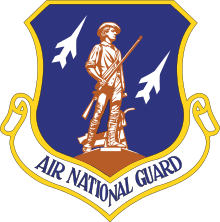157th Fighter Squadron
The 157th Fighter Squadron (157 FS) is a unit of the South Carolina Air National Guard 169th Fighter Wing located at McEntire Joint National Guard Base, Columbia, South Carolina. The 157th FS is one of the few Air National Guard squadrons to operate the HARM Targeting System (HTS)-equipped F-16C Block 52 Fighting Falcon, also known as the F-16CJ.
| 157th Fighter Squadron | |
|---|---|
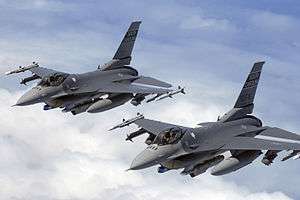 Swamp Foxes in the air. Demon flight of F-16 pilots from the 169th Fighter Wing, South Carolina Air National Guard flies a training mission in the KIWI MOA airspace over the coast of North Carolina. | |
| Active | 1942–1945; 1946–1952; 1952–present |
| Country | |
| Allegiance | |
| Branch | |
| Type | Squadron |
| Role | Tactical Fighter |
| Part of | South Carolina Air National Guard |
| Garrison/HQ | McEntire Joint National Guard Base, Eastover, South Carolina |
| Nickname(s) | Swamp Fox |
| Engagements | World War II, Operation Desert Storm, Operation Enduring Freedom, Operation Iraqi Freedom |
| Decorations | Distinguished Unit Citation[1] |
| Insignia | |
| 157th Fighter Squadron emblem | 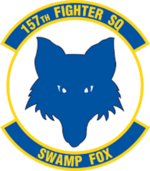 |
| Patch with 157th Fighter-Interceptor Squadron emblem | 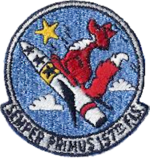 |
| 350th Fighter Squadron emblem | 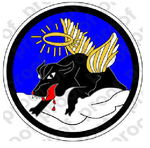 |
| Tail stripe | South Carolina |
History
World War II
- see: 353d Fighter Group for full World War II history
Activated in late 1942. Trained under First Air Force in northeastern United States with P-40 Warhawks, also performing Air Defense as part of Norfolk and Philadelphia Fighter Wings. Deployed to European Theater of Operations, June 1943, being equipped with P-47 Thunderbolts in England. Assigned as a heavy bomber escort squadron under VIII Fighter Command. Re-equipped with long-range P-51D Mustangs, July 1944, Thunderbolts being transferred to IX Fighter Command as tactical fighter-bombers supporting ground forces in France. Performed bomber escort missions until the end of the war in Europe, April 1945.
Squadron demobilized in England during the summer of 1945, inactivated in United States as a paper unit, October 1945.
South Carolina Air National Guard

The wartime 350th Fighter Squadron was re-activated and re-designated as the 157th Fighter Squadron, and was allotted to the South Carolina Air National Guard, on 24 May 1946. It was organized at Congaree Air Base, Columbia, South Carolina and was extended federal recognition on 9 December 1946 by the National Guard Bureau. The 157th Fighter Squadron was bestowed the history, honors, and colors of the 350th Fighter Squadron and assigned to the Georgia ANG 54th Fighter Wing, an umbrella organization formed for administrative and logistical support for many Air National Guard units in the southeastern United States. It remained, however, under the operational control of the South Carolina Air National Guard.
The 157th was equipped with F-51D Mustangs and was assigned an air defense mission for the state of South Carolina. In 1950 the 157th was re-equipped with former World War II F-5 Mustangs, now designated RF-51D which had been used in the United States in a training role. The squadron became part of Tactical Air Command (TAC) as a Tactical Reconnaissance Squadron.
Korean War activation
The 157th Fighter Squadron was federalized due to the Korean War on 10 October 1950. On 1 November the RF-51 Mustangs were transferred to other units and the 157th was re-equipped with RF-80A Shooting Star photo-reconnaissance jets and transferred to Lawson AFB, Georgia. At Lawson, the wartime 117th Tactical Reconnaissance Group was formed with the 157th along with the 160th TRS (Alabama ANG) with RF-80As and the 112th TRS (Ohio ANG) with RB-26C Invader Night Reconnaissance aircraft. The 117th Tactical Reconnaissance Group was assigned to Ninth Air Force, Tactical Air Command.
The 117th TRG then began what was then believed to be a short transition training period. The original plan was to deploy the 117th to France and reinforce the United States Air Forces in Europe at a new base in France, Toul-Rosières Air Base. However Toul Air Base was still under construction, and delays in France for several reasons forced the 117th to remain at Lawson AFB for over a year until finally receiving deployment orders in January 1952.
The 117th arrived at Toul Air Base on 27 January 1952. However at the time of the Wing's arrival, Toul AB consisted of a sea of mud, and the new jet runway was breaking up and could not support safe flying. The commander of the 117th deemed it uninhabitable and its flying squadrons of the wing were ordered dispersed to West Germany. The 112th TRS was transferred to Wiesbaden AB, the 157th TRS deployed to Fürstenfeldbruck AB, and the 160th deployed to Neubiberg AB. The non-flying Headquarters and Support organizations were assigned to Toul.
The mission of the 117 TRW was to provide tactical, visual, photographic and electronic reconnaissance by both day and night, as was required by the military forces within the European command. The RF-80s were responsible for the daylight operations; the RB-26s for night photography. In June 1952, the 117th was involved in Exercise 'June Primer'. This exercise took place in an area bordered by a line drawn from Cherbourg to Geneva in the east and in the west by this Swiss, Austrian and Russian occupation zone borders.
The two RF-80 squadrons of the 117th had to complete a number of varying missions, including vertical photography of prospective paratroop air drop zones, oblique photos of the Rhine and Danube river bridges, vertical photography of the airfields of Jever, Fassburg, Celle, Sundorf and Gütersloh and various visual missions on behalf of the seventh army, including artillery adjustment for the 816th field artillery. The 157 TRS had had wire recorders fitted to five of its RF-80s prior to June Primer and these greatly facilitated the latter missions.
By July 1952 the facilities at Wiesbaden AB were becoming very crowded, and it was felt that the B-26's could fly from the primitive conditions at Toul. The 112 TRS returned to Toul, however the jet-engined RF-80s remained in West Germany until a new runway was constructed.
On 9 July 1952 the activated Air National Guard 117 TRW was released from active duty and inactivated in place and its mission was taken over by the newly activated 10th Tactical Reconnaissance Wing. All of the aircraft and support equipment remained at Toul and was transferred to the 10th TRW.
Air Defense

After returning from West Germany, the squadron was re-formed at Congaree Air Base and the South Carolina Air National Guard assumed an air defense mission. Due to the lack of jet aircraft in the United States (most were being used in the Korean War), the 157th was re-equipped with very long-range F-51H Mustangs and the unit was allocated to the Eastern Air Defense Force, Air Defense Command (ADC). After the Korean Armistice in 1953, the 157th began to receive F-86A Sabre jets, pressed into the daylight interceptor mission by ADC. In 1954, the Mustangs were reaching the end of their service life, and ADC supplied the 157th with some F-80C Shooting Stars as an interim replacement.
On 5 September 1957, the 157th Fighter-Bomber Squadron was authorized to expand to a group level, and the 169th Fighter-Interceptor Group was established by the National Guard Bureau. The 157th was re-designated as a Fighter-Interceptor squadron and became the group's flying squadron. Other squadrons assigned into the group were the 169th Headquarters, 169th Material Squadron (Maintenance), 169th Combat Support Squadron, and the 169th USAF Dispensary.

Shortly afterwards Air Defense Command upgraded the new 169th FIG to the all-weather/day-night F-86L Sabre Interceptor aircraft.
In 1960 ADC released all its F-104A Starfighters to the ANG because the F-104 fire control system was not sophisticated enough to make it an all-weather interceptor.[2] The 157th was one of three selected ANG units to receive the Starfighter Mach-2 interceptors. The "Swamp Foxes", as a result of the national recognition as one of the best air defense units in the nation, were chosen to fly the new high performance jet fighter.
Brigadier General Barnie B. McEntire, Jr., the first commander of the South Carolina ANG and its first general officer died 25 May 1961, when he courageously piloted his malfunctioning F-104 fighter jet away from populated areas near Harrisburg, Pennsylvania, to crash into the Susquehanna River. On 1 October 1961, then-Governor Ernest F. Hollings presided over the ceremony renaming the heroic wing commander's South Carolina installation from Congaree Air Base to McEntire Air National Guard Base.
The 169th FIG was called into active service a second time in November 1961 as the construction of the infamous "Berlin Wall" pushed the world to the brink of war. Within a month after mobilization, 750 personnel and 22 157th FIS F-104 aircraft were in place at Morón Air Base, Spain as the unit took up flying daily air defense patrols as part of the NATO air defense force in Western Europe. With world tension easing, the squadron returned home in August 1962.
Following the Cuban missile crisis, ADC decided to make a permanent fighter unit at Homestead Air Force Base an F-104 unit because of its superior fighter-on-fighter performance. The F-104's lack of an all-weather capability not a factor because Cuba lacked a bomber force.[3] In June 1963 the F-104s were transferred back to the active-duty Air Force. The South Carolina ANG was re-equipped with F-102A Delta Daggers, which became available because of Project Clearwater, which withdrew F-102s from overseas bases.[4] The "Deuce", still a very potent interceptor, served with the 169th FIG until April 1975, when Aerospace Defense Command was reducing the USAF interceptor force as the threat of Soviet Bombers attacking the United States was deemed remote.
Tactical Air Command

With the phase-down of continental air defenses in the 1970s, the 169th was transferred to Tactical Air Command (TAC), and was re-designated a Tactical Fighter Group. The 157th Tactical Fighter Squadron began to receive A-7D Corsair II subsonic tactical close air support aircraft from Tactical Air Command units that were preparing to receive the new A-10 Thunderbolt II. Receiving its aircraft from the 354th TFW at Myrtle Beach AFB and the 355th TFW at Davis-Monthan AFB, Arizona. The aircraft had excellent accuracy with the aid of an automatic electronic navigation and weapons delivery system. Although designed primarily as a ground attack aircraft, it also had limited air-to-air combat capability. In 1982, the 157th received new twin-seat A-7K trainers.

In the early 1980s, the South Carolina congressional delegation in Congress, led by Senators Strom Thurmond and Ernest Hollings, pressured the Department of Defense to upgrade Army and Air National Guard units with front line equipment to better supplement the Active Duty forces as part of the "Total Force" concept. Specifically, Thurmond and Hollings wanted the Air Force to equip the South Carolina ANG with the new F-16 Fighting Falcon, which was, as the time, just being introduced into the active duty force of Tactical Air Command. Beginning in July 1983, some of the initial Block 1 and Block 5 F-16As were transferred to the 169th Tactical Fighter Group, being the first Air National Guard unit to receive the aircraft. Its A-7Ds were subsequently reassigned to other Air National Guard units. Later, Block 10 F-16A/B were delivered by the Air Force to the 157th TFS. By the mid eighties all the F-16s received by the 169th had undergone Pacer Loft modification bringing them up to the same block 10 standard.
With the equipment change to the F-16, the 169th was assigned to the air defense mission again under Air Defense, Tactical Air Command (ADTAC), which was established when TAC assumed the Aerospace Defense Command mission in 1979. In addition, although the F-16s weren't adapted to perform in the tactical close air support mission that the A-7D was utilized for, the 157th TFS did practice the conventional attack role with Mark 82 (Mk 82) and Mark 84 (Mk 84) gliding bombs. The quality of the pilots and ammunition/maintenance crews of the 157th TFS was demonstrated during Gunsmoke '89 held at Nellis AFB from 1 October till 14 October. The 157th TFS took first place out of 15 other teams.
In December 1990, during the buildup for war during Operation Desert Shield, the 157th was federalized for a third time and was deployed to Prince Sultan Air Base, Al Kharj, Saudi Arabia just a year and a half after taking first place at Gunsmoke '89. The 157th Tactical Fighter Squadron (Provisional) flew a total of 1,729 combat sorties during Operation Desert Storm. A total mission rate of over 90% was achieved, which was quite a remarkable feat.
Post Cold War era

Early in the 1990s with the declared end of the Cold War and the continued decline in military budgets, the Air Force restructured to meet changes in strategic requirements, decreasing personnel, and a smaller infrastructure. The 169th adopted the new USAF "Objective Organization" in early 1992, with the word "tactical" being eliminated from its designation and becoming the 169th Fighter Group. Tactical Air Command was inactivated on 1 June, being replaced by the new Air Combat Command (ACC).
In 1995, the 157th Fighter Squadron became the recipient of brand-new Block 52 F-16C/D Fighting Falcons coming straight from the Lockheed facility at Fort Worth, Texas. The 169th Fighter Group becoming the first AirNational Guard unit to receive these state-of-the-art aircraft. The mission profile of the unit changed in the way that they became a multi-role squadron being able to perform all kind of missions. More specifically they also received the HARM Targeting System being able to fly anti-radar sorties with the AGM-88 anti-radar missile.

The main mission profile of the squadron therefore changed to that of Suppression of Enemy Air Defenses (SEAD). The 157th Fighter Squadron continues to fly the SEAD mission today. Also, on 11 October 1995 ACC and the National Guard Board authorized the status of the 169th to be expanded to the Wing level, and the 157th Fighter Squadron became part of the new 169th Operations Group under the new 169th Fighter Wing.
In mid-1996, the Air Force, in response to budget cuts, and changing world situations, began experimenting with Air Expeditionary organizations. The Air Expeditionary Force (AEF) concept was developed that would mix Active-Duty, Reserve and Air National Guard elements into a combined force. Instead of entire permanent units deploying as "Provisional" as in the 1991 Gulf War, Expeditionary units are composed of "aviation packages" from several wings, including active-duty Air Force, the Air Force Reserve Command and the Air National Guard, would be married together to carry out the assigned deployment rotation.
In February 1997, the 157th Expeditionary Fighter Squadron (157 EFS) was first formed from 169th FW personnel and aircraft and deployed to Doha International Airport, Qatar, to join with other active-duty and national guard squadrons as part of Operation Southern Watch. This mission was initiated mainly to cover for attacks of Iraqi forces on the Iraqi Shi’ite Muslims. This made the 169th the first Air National Guard unit to deploy alongside active-duty Air Force units to comprise an Air Expeditionary Force (AEF).
The 157th EFS was activated again in January 2000 as a component of Operation Northern Watch; a United States European Command Combined Task Force (CTF) who was responsible for enforcing the United Nations mandated no-fly zone above the 36th parallel in Iraq. This mission was a successor to Operation Provide Comfort which also entailed support for the Iraqi Kurds. The deployment was completed in April 2000. The 157th EFS was formed again in March 2001, when the unit deployed to Prince Sultan AB, Saudi Arabia in a second Operation Southern Watch deployment. The guardsmen returned to McIntire JGB in July.
Global War on Terrorism

In 2002, aircraft and personnel from the 169th deployed to Southwest Asia in support of Operation Enduring Freedom (OEF) and participated directly in combat operations. Also that year, 50 South Carolina ANG airmen, then assigned to the 240th Combat Communications Squadron, deployed to Central Asia for six months in support of the Global War on Terrorism, and the 245th ATCS deployed to Afghanistan in support of Operation Enduring Freedom.
In 2003, nearly 400 Airmen from the 169th and all its F-16s were mobilized and deployed to Southwest Asia as part of what became Operation Iraqi Freedom (OIF). The 169th was attached to the 379th Air Expeditionary Wing, stationed in Qatar, and flew more than 400 combat missions (performing the Suppression and Destruction of Enemy Air Defenses mission and flying numerous precision bombing missions over Iraq.

In 2005, the Base Realignment and Closure Commission announced an historic expansion at McEntire. Five more Block 52 F-16s from the active duty USAF would arrive at the base in 2006 and five more the following year. Then, in 2007, active duty Air Force personnel began arriving at McEntire as the base prepared to host and operate the largest Active Association unit in the nation's Combat Air Forces, bringing about 150 active duty personnel on board to work, train and deploy with the 169th.
In May 2010, the 169th became the first Air National Guard unit to support an AEF mission for a full 120 days. While simultaneously deploying Airmen for Operation Enduring Freedom, the wing deployed more than 300 Airmen in support of Operation Iraqi Freedom, during which the 169th flew more than 800 combat air patrol missions over Iraq from Balad AB and other locations. The unprecedented deployment also allowed the 169th team to escort the last Army combat forces out of Iraq on the last day of OEF.
Starting in October 2010 the 157th FS began an Air Sovereignty Alert mission at nearby Shaw AFB. The squadron gradually took over the alert duties of the 20th Fighter Wing and, on 6 May 2011, the squadron completely took over the role when a new alert facility was built at McEntire Joint National Guard Base.
Most recently, in April 2012, the 157th EFS was formed and deployed with pilots, maintenance specialists and support staffers. They provided air support to ground units from Kandahar Airfield, Afghanistan. Pilots flew more than 2,200 sorties for a total of 9,400 combat hours. The four-month deployment ended in late August.
Although not confirmed it has been discussed that the 157th Fighter Squadron will likely be re-equipped with the Lockheed Martin F-35A Lightning II early in its roll-out to active duty USAF units such as the 20th Fighter Wing at nearby Shaw AFB, as the South Carolina ANG has a history of receiving the newest equipment when it becomes available.
Lineage
- Constituted as 350th Fighter Squadron on 29 September 1942
- Activated on 1 October 1942
- Inactivated on 18 October 1945.
- Re-designated: 157th Fighter Squadron, and allotted to South Carolina ANG, on 24 May 1946
- Extended federal recognition on 9 December 1946
- Federalized and ordered to active service on: 10 October 1950
- Re-designated: 157th Tactical Reconnaissance Squadron, 10 October 1951
- Relieved from active duty and returned to South Carolina State Control: 9 July 1952
- Re-designated: 157th Fighter-Bomber Squadron on 10 November 1952
- Re-designated: 157th Fighter-Interceptor Squadron on 5 September 1957
- Federalized and ordered to active service on: 1 November 1961
- Relieved from active duty and returned to South Carolina State Control: 15 August 1962
- Re-designated: 157th Tactical Fighter Squadron on 1 April 1975
- Federalized and ordered to active service on: 29 December 1990
- Deployed elements designated: 157th Tactical Fighter Squadron (Provisional), 29 December 1990
- Relieved from active duty and returned to South Carolina State Control: 22 July 1991
- Re-designated: 157th Fighter Squadron on 15 March 1992 – present
- Components designated as: 157th Expeditionary Fighter Squadron when deployed as part of an Air and Space Expeditionary unit after June 1996.
Assignments
- 353d Fighter Group, 1 October 1942 – 18 October 1945
- 54th Fighter Wing, 9 December 1946
- 117th Tactical Reconnaissance Group, 10 October 1950
- 116th Fighter-Interceptor Group, 10 July 1952
- 116th Fighter-Bomber Group on 1 December 1952
- 116th Fighter Group (Air Defense), 1 July 1955
- 169th Fighter-Interceptor Group, 5 September 1957
- 169th Tactical Fighter Group, 1 April 1975
- Elements attached to: 4th Tactical Fighter Wing (Provisional), 29 December 1990 – 22 July 1991
- 169th Fighter Group, 15 March 1992
- 169th Operations Group, 11 October 1995 – present
Stations
|
|
South Carolina Air National Guard deployments
|
|
Aircraft
|
|
See also
References
Notes
- Maurer, Combat Squadrons, p. 435
- McMullen, Richard F. (1964) "The Fighter Interceptor Force 1962–1964" ADC Historical Study No. 27, Air Defense Command, Ent Air Force Base, CO (Confidential, declassified 22 March 2000), p. 6
- McMullen, p. 18
- McMullen, p. 51
Bibliography
![]()
- Maurer, Maurer, ed. (1982) [1969]. Combat Squadrons of the Air Force, World War II (PDF) (reprint ed.). Washington, DC: Office of Air Force History. ISBN 0-405-12194-6. LCCN 70605402. OCLC 72556.
- McMullen, Richard F. (1964) "The Fighter Interceptor Force 1962–1964" ADC Historical Study No. 27, Air Defense Command, Ent Air Force Base, CO (Confidential, declassified 22 March 2000)
External links
- 169th Fighter Wing history website
- 169th Fighter Wing@globalsecurity.org
- Rogers, B. (2006). United States Air Force Unit Designations Since 1978. ISBN 1-85780-197-0
- 157th Fighter Squadron@f-16.net
- Cornett, Lloyd H. and Johnson, Mildred W., A Handbook of Aerospace Defense Organization 1946–1980, Office of History, Aerospace Defense Center, Peterson AFB, CO (1980).
- Official site of the 169th Fighter Wing
